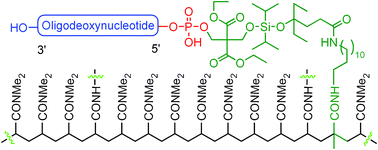The readily scalable catching by polymerization purification technology has been further advanced to purify 5′-phosphorylated synthetic oligodeoxynucleotides (ODNs). The new technology utilizes a phosphoramidite that contains a fluoride-cleavable diisopropylsilyl acetal linker and a polymerizable methacrylamide group, and is capable of phosphorylation of ODN. For purification, the phosphoramidite was coupled to the 5′-end of full-length ODN on a synthesizer. Because failure sequences were capped in each synthetic cycle, only the full-length sequences were phosphinylated and acrylated. After cleavage and deprotection, the crude ODN was subjected to polymerization under typical acrylamide gel formation conditions. The full-length ODN was incorporated into polymer. The failure sequences and other impurities were simply removed by washing with water. Pure full-length ODN that contained a 5′-phosphate group was cleaved from the polymer with HF–pyridine. Reversed-phase (RP) HPLC showed that the ODN was pure, and the recovery yield was higher than that of typical preparative HPLC purification.
